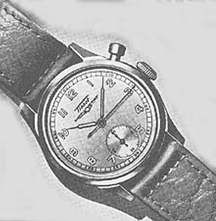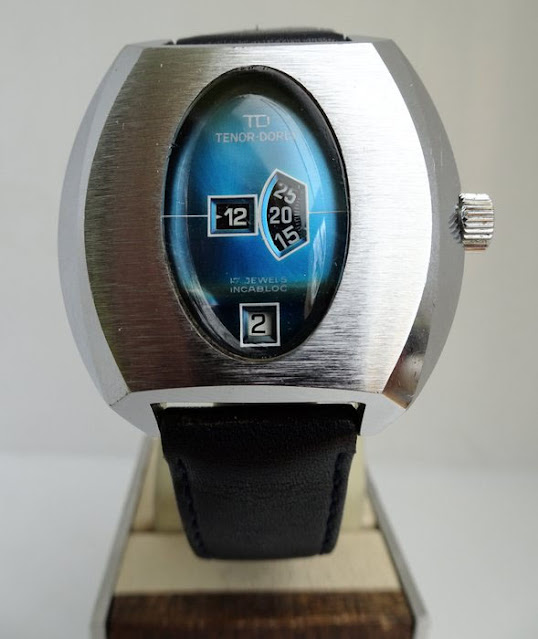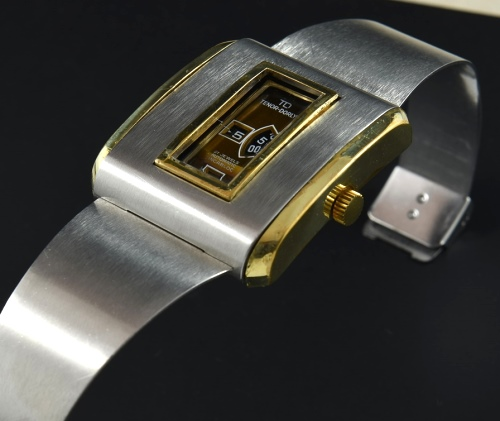By Bruce Shawkey
Tissot was founded by Charles-Felicien Tissot and his son Charles-Emile. Charles-Felicien, born in 1804, had been a Tissot watchmaker in the Jura region of Switzerland. His son, Charles-Emile, born in 1830, apprenticed as a watchmaker in his father's workshop beginning at age 12. It must have been in his blood to be a watchmaker because he completed his training very quickly and, in 1848 at the relatively young age of 18, sailed across the ocean to America at the request of an uncle to repair timepieces there. Quickly becoming excited over the possibility of supplying new markets with timepieces, young Charles-Emile was not content to stay in America repairing other manufacturers' watches. And so five years later, he returned to Switzerland and convinced his father to go into business supplying watches with the family name to the world.
Thus, in 1853, the firm of Ch. F. Tissot & Fils. was born in the city of Le Locle. The father tended to the home fires, overseeing production, while the son handled the marketing. Over the course of the next 43 years, Charles Emile would undertake no fewer than 52 journeys to North America and Russia. The greater market potential at the time (pre-revolution) was Russia, so Charles Emile concentrated his efforts there. Only one rail line operated during this time, from Moscow to St. Petersburg, so Charles Emile often traveled to the far reaches of Russia by troika, a Russian carriage pulled by a team of three horses. Considering his fragile and precious cargo - consisting of watches bearing not only his family name but other luxury Swiss timepieces including Audemars Piguet - it was a perilous way to travel to say the least! Through the son's industrious efforts and carefully chosen alliances with sales agents, Tissot would eventually earn the prestigious title of “Purveyor to the Tsar's Court.”
In 1873, when Charles Felicien died, his widow watched over the company at home while Charles-Emile continued to travel and develop new markets. By 1883, Charles-Emile brought his son, Charles Tissot, then age 23, into the business. For the next two decades, son and grandson would continue to develop the business and earn awards for their watches in various prestigious competitions throughout Europe, while still concentrating their sales efforts in Russia.
Birth of the wristwatch
As with many manufacturers, we do not know exactly when Tissot began to market wristwatches. Some historians have suggested that Tissot began experimenting with wrist watches as early as 1900. Others say Tissot's first commercially produced wristwatches for women came out in 1911 or '12, with men's wristwatches following in about 1915. The men's watches were classic round shapes, many with a decidedly “military” look as seen on the image to the left.
At this point, I should make a clarification. There is some confusion between Tissot watches and those manufactured by Mathey-Tissot. They are totally different manufacturers, with the latter being founded in 1886 by Edmund Mathey-Tissot.
Soon after 1915, Tissot came out with a long curved rectangular dress watch (right) that modern-day
collectors refer to as the “Banana Watch.” Originals were fragile and today are scarce. Tissot has, in fact, reproduced this model as part of its “Heritage,” series and is called the Prince. With its “exploding” numerals, it is a very striking watch to this day. I own a copy and it is one of the few watches on which I get compliments from non-collectors, and they are surprised to learn the watch design if more than 100 years old! Charles-Emile passed away in 1910. At that time, the fourth generation joined the firm when Charles' son, Paul, joined the business. At the relatively young age of 20 years, Paul would soon become instrumental in the company's future. Paul's sister, Marie Tissot, also joined the company during this time (1916) and would become instrumental in her own right as to the company's future.
Things would begin to change radically for Tissot soon enough. The success Tissot had enjoyed in Russia was about to end. With the revolution of 1917, the watch market in Russia virtually collapsed overnight. Tissot would have to find new markets, and their approach to this would be ingenious, as we will soon see. But prior to embarking on a new marketing strategy, Charles, son Paul and daughter Marie first concentrated on the manufacturing process itself. Tissot began producing their own watch movements in their spacious and modern facilities (updated in 1908) to reduce their dependence on ebauches (rough movements) from other manufacturers.
The clear leader to emerge during this time was Paul. His strong personality, along with production improvements, brought him attention from many watch manufacturers, but in particular the Brandt family which owned and operated Omega. The two formed an alliance in the early 1920s that would more than compensate Tissot for its lost market in Russia. That alliance would also irrevocably fuse the two companies in the eyes of jewelers, the buying public and, eventually, collectors. In 1925, Paul was made a director of Omega and, in 1929, the companies officially merged. Omega, which had already established a stronghold in the United States, became the distributing agent for Tissot. It is ironic how, today, many collectors think of Tissot as a “poor-man's Omega” because for many decades Tissot was promoted as the “higher-end” watch while Omega covered the “lower luxury” market.
The streamlining that had begun in the 1920 continued, so that at one point, Tissot offered 42 different models of watches using only five different cases. Examples of these can be seen below:

This period also saw technical innovation. For example, during the 1930s, Tissot introduced the industry's first anti-magnetic watch - a revolutionary development that would eventually benefit the entire watch industry. Magnetism is a watch movement's invisible enemy, eventually causing it to run erratically. During the late '30s, Tissot also introduced a water-resistant case that utilized clips to hold the back to the case. Later case designs would use screws in the back of the watch in conjunction with metal tabs that would “squeeze” the back to the case. Other innovations would follow, which I will discuss in a moment.
While Omega and Tissot tried their best to keep their brands distinct through the coming decades, the inevitable melding of the two did occur. It is possible (though not common), for example, to find watches during the 1930s - 1950s, that are signed both Omega and Tissot on the dial (left). Other Tissot models shared basic movement calibers with Omega watches, particularly chronographs which tended to utilize ebauches as a basic platform.
Many ladies' watches of the period (1930s - '40s) meanwhile, took on a more sporty/athletic look. Many had sweep seconds or auxiliary seconds hands, almost unheard of in ladies' watches of the day, except for nurses. This suggests that Tissot was appealing to a wider market than just the “watch-as-jewelry” look emphasized by other manufactures.
As mentioned previously, the collaboration of Tissot and Omega that began in 1925 was formalized in 1930 when the company entered into a community of interests that led to the foundation of the Societe Suisse pour l'Industrie Horlogere S.A. (SSIH), headquartered in Geneva. In 1932, SSIH was joined by Lemania which effectively supplied the consortium (though not exclusively) with chronograph ebauches. Another consortium of watchmakers, ASUAG, which was formed in 1931, would eventually figure into Tissot's future. In 1983, the two consortiums would merge to form SMH which would eventually become the Swatch Group Ltd. So today, Tissot is part of Swatch which, through the years and through various mergers and acquisitions, has become the umbrella corporation for some 20 watch and jewelry brands and is the largest manufacturer and distributor of finished watches in the world.
During the years that led to the end of Tissot as an independent company, Marie Tissot played an integral part. Born in Moscow, the sister of Paul Tissot joined the company in 1916 as an administrator, as previously mentioned. But eventually she would take over the whole accounting department. She is said to have given the company a “soul.” She created the social department in Tissot, as well as a trust fund which benefited not only workers (male AND female), but their widows and orphans. It was one of the first companies to take on such a responsibility to the workers and their families. But at the same time, Marie was a staunch business woman, and all the construction and modifications to the factory required her assent before they could commence. Certainly, she was a woman ahead of her time and an anomaly in the male-dominated business world at that time, especially in Switzerland. She died in 1980 at age 83.
Her brother, Paul, meanwhile, passed away in 1951 at the relatively young age of 61 while at the top of his career at Tissot. After Paul's death, his cousin, Edouard-Louis Tissot (born 1896), already member of the board of directors of the SSIH group, agreed to come back to Switzerland and to take over the management of Tissot, together with Marie. He had studied as an electrical engineer in Switzerland and since 1924 was as an engineer in Argentina, where he founded the “Compagnie Suisse-Argentine d'Electricité.” He died in 1977.
Luc Tissot, the son of Edouard-Louis, born in 1937, also an engineer, was the last managing director of Tissot. He left the company in 1981 approximately two years before the merger of SSIH and ASUAG. As you can see, Tissot was a company steeped in family history.
The watches
I have discussed some of the innovative watches introduced by Tissot through the 1930s. And many more were to come. Let’s take a look at some of their watches up to the start of WWII.

 |
| Tissot Militar |
In 1942, Tissot came out with a watch that is today one of the more collectible of Tissot watches - the Mediostat. It has an independent large sweep second hand that starts, stops and resets with the use a single pusher button. A constant seconds hands is located on
a subsidiary chapter at 6:00. Elapsed time of up to one minute can be measured, or longer if the user can remember how many times the large second hand has traversed the circumference of the dial. The watch was pitched to physicians, where it proved quite useful for taking patients' pulses. But technicians, scientists, and so forth could also make use of this feature. The model was even touted during the second world war years as a useful watch for artillery men, bombardiers and so forth to measure time between bomb launch and detonation.Tissot Mediostat
At this point, we’ll take a look at some Tissot watches from a rare 1943 catalog from my collection. The text appears to be in Swiss German. While there are no military watches, per se, some of the watches have a military look to them.

Eventually, many of Tissot's automatic watches took on the initials “PR” in their reference. The first in the PR series was the “PR516” manufactured in 1956. The PR has stood for several meanings over the years, including Precision Resistance, Particularly Resistant, and Precise and Robust.
One caliber in particular, launched in 1951, the 28.5N-21, became the platform for what is arguably Tissot's most famous vintage wristwatch. In 1953, the company used this caliber in a revolutionary new watch, called the Navigator (left). It is easy to spot, because an independent inner dial contains cities of the world printed vertically on it. It has a very unique operation. Pulling out the crown releases the inner dial with the cities printed on them. Turning the crown turns the cities dial. Turn until the city in your location is aligned with the numeral 24 on the outer dial. Then, press the pusher button (on some models a pin is required). This disengages the inner dial and allows you to set the correct local time. Push the crown in, the pusher button again pops back out, and the watch works in its normal mode. Time can then be seen in cities around the world relative to local time. The watch was made until 1960, at which time the caliber was discontinued as well. It is a rare watch indeed, and the few times one comes up for sale it is usually with high-profile auction houses such as Sotheby's or Christies. Tissot offered a true reproduction of the Navigator a few years back, cased in 18kt gold, with a production of 100 pieces.
The 1960s and beyond
The 1960s were turbulent times for the watch industry, as mainstream manufactures struggled to compete against the onslaught of the throw-away watches by Timex (pin-lever) and the cheaper jeweled-lever imports. Tissot made a gallant effort to remain a premium watch.
But no watch manufacture remained immune from the public's taste for cheap watches.
Tissot, like everyone else, looked for ways to lower the cost of production. A breakthrough occurred in 1969 when Tissot rolled out its first “Sideral” model (right). The case was made of plastic reinforced with fiberglass. The name Sideral was a marketing ploy and referred to sidereal time, which is time based on the rotation of the earth with reference to the background of the stars. For example, a sidereal day is the exact time required for a complete revolution of the earth, which is equivalent to 23 hours, 56 minutes, 4.09 seconds in terms of solar mean time, which is the standard unit of time measure (i.e., 24 hours in a day). Of course, the watch does not keep sidereal time. It was simply Tissot's attempt to come with a catchy name. The first in the Sideral series of plastic-cased watches was an automatic model, but was followed by electric and chronograph models as well. Models often have an inset screw on the back to fine-tune the time. This eliminates the need to open the case for routine timing adjustments. The initial price of the automatic model was 105 Swiss francs, equivalent to about $24 U.S. dollars at the time. That was about half the price of the most basic man's Tissot model cased in metal.
Two years later, in 1971, Tissot would carry this innovation one step further by introducing a watch with a plastic movement called the Astrolon or, in some cases, the “Sytal,” an acronym for “Systeme Total d'Autolubrification.” The majority of the parts - wheels, pinions, escapement, and plates - were all cast from plastic, and much of the watch movement was machine-assembled. The only metal components were the balance assembly, the mainspring, barrel, and the winding mechanism. Various parts of the movement are red, white, and blue - a nice touch. The number of parts were reduced from 90 in a conventional movement to 52. Because the movement was self-lubricating, the word “Autolub” was added to some models. The caliber designations were 2250, 2270 (date) and 2280 (day and date). One very distinctive model, the “Idea 2001,” was housed in a clear plastic case so the movement was visible. Most of the models had cases that were sealed. Furthermore, the movements could not be disassembled; they had to simply be replaced. Priced from $22.50 to as low as $8, they were designed as throw-away watches, only better, according to Tissot. The watch withstood normal water immersion tests to 30 psi, and Tissot's engineers claimed that the timepiece could compete with a chronometer for accuracy and reliability. Some models were eventually made with cases that could be taken apart, so that the movement could at least be swapped out if problems arose. The watch, however, faced several problems, not the least of which was the introduction of commercially viable quartz watches. The Astrolon project was soon dropped and today, the watches (in particular, the Idea 2001 model) are quite collectible.
Some collectors believe the Astrolon was the forerunner to the Swatch Watch, introduced in 1983. While there are many similarities, I still place the Astrolon in a separate category, since it still relied on a mechanical movement while Swatch Watches, at least initially, were strictly quartz watches (through many mechanical Swatch models were eventually and continue to be released).
The trend toward making cases out of nontraditional materials would continue into the 1980s, as Tissot introduced watches with cases made of granite, mother of pearl, wood, and ceramic.
In 1996, the company introduced the Autoquartz, with the ETA Caliber 205.111 movement. It is a hybrid between mechanical and quartz watch, like the Seiko Kinetic. But the similarities end there. The mechanics work in a totally different manner.
The company has made a marvelous comeback from its days of making “throw-away” watches, due in part to the renaissance of the Swiss watch industry as a whole. The public's taste has turned around to more durable goods of all kinds, which translates to better quality watches. Today, the Tissot line is divided into several categories ranging from the “vintage look” to watches that appeal to those on the leading edge of technology.
Perhaps the most impressive watch to come out of the "techy" category is Tissot's “T-Touch” touch Screen watch. Introduced in 1999, the company claims it was the first watch with a touch-sensitive dial. Various functions of the watch are activated by touching the crystal of the watch. The watch was available in either stainless or titanium case. I lost track of all the functions back in 2014 when T-Touch had been increased to 25 different functions!

















































